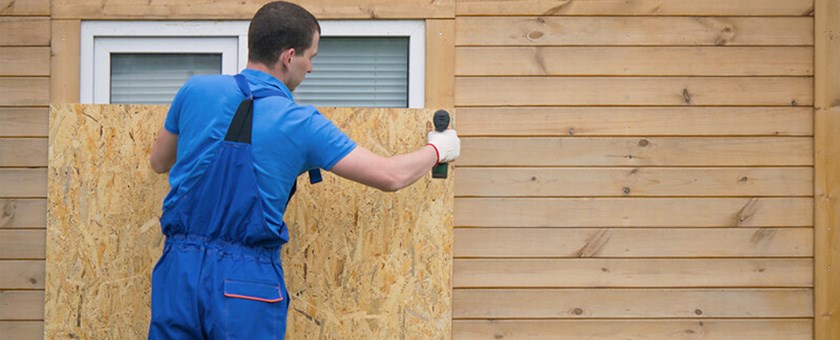Severe windstorms pose a significant threat to small businesses across Canada. These natural disasters can lead to property damage, operational disruption and financial loss. Gallagher is here with valuable tips for protecting your property during windstorms.
As the impacts of climate change continue to grow, the frequency of severe windstorms is on the rise. Recent events have demonstrated the devastating potential of summer storms, characterized by strong winds and hail. These storms can wreak havoc in a matter of minutes, causing damage to your property, windows, doors and personal belongings.
By understanding the risks and taking proactive measures, you can minimize damage. At Gallagher, we're committed to helping you safeguard your property and minimize potential risks. In this article, we share valuable tips for protecting your property during severe windstorms.
Preventive maintenance to protect your property
Taking simple, yet effective preventive measures can significantly reduce the severity of damage during a severe windstorm. Here are some key steps you can take:
- Regular property maintenance. The foundation of protecting your property begins with regular maintenance. Before windstorm season arrives, inspect your property for loose shingles, damaged siding and weak trees that could pose a risk. Promptly address these issues to prevent them from worsening during a storm.
- Protect windows and glass doors. Storm shutters are your first line of defense against windborne debris. Consider adding shatter-resistant film or stormproof high-impact glass to reinforce your windows and protect them from breaking.
- Reinforce doors and double-entry doors. High wind pressure can cause these doors to fail. Strengthen garage doors with girts and reinforce wheel tracks. For double-entry doors, use heavy-duty deadbolts, slide bolts and longer hinge attachments for added security.
- Trim or remove dead, damaged or rotted trees and limbs. High winds can easily topple trees and branches. Regularly trim or remove damaged trees from your property, ensuring your home is at least 12 metres away from any tree base.
- Seal cracks and gaps. Prevent wind and water infiltration by maintaining well-sealed caulking around windows and doors. Fill any gaps around pipes or wires with waterproof sealant to keep your building secure.
Preparing right before the windstorm
Don't wait until the winds pick up to take action. When a severe windstorm is approaching, follow these critical steps:
- Stay informed. Listen to local area radio or TV stations for the latest updates and information.
- Seek shelter. Move to an underground shelter, basement or a safe room in a sturdy building. If none is available, find a small, windowless interior room or hallway on the lowest level of a sturdy building. Avoid staying in mobile homes, which aren't safe during tornadoes.
- Know evacuation routes. Familiarize yourself with the routes to the nearest emergency shelter in case you need to evacuate.
If you're caught outdoors during a windstorm
If you're outdoors when a severe windstorm strikes, follow these guidelines:
- Seek shelter. Find a basement, shelter or a sturdy building for protection.
- Stay in your vehicle. If you can't reach shelter quickly, get into your vehicle and drive to the nearest sturdy shelter. Remember to wear your seat belt.
- Avoid bridges and overpasses. Stay away from bridge and highway overpasses.
- If driving in strong winds. If you encounter strong winds and flying debris while driving, pull over and park safely. Keep your seat belt on, lower your head below the windows, cover yourself with a blanket and protect your head with your arms.
After the windstorm hits
Given the unpredictable nature of windstorms, there may be instances when your property sustains damage. In such cases, follow these steps:
- Protect the property. If you suspect structural, electrical or gas-leak hazards, shut off electrical power, natural gas and propane tanks to prevent further damage. Contact the appropriate authorities and utilities, such as gas and electric companies.
- Power loss. If you lose power, turn off all appliances and tools to prevent power surges from damaging tools when power is restored.
- Document damage. Whenever possible, take photos and videos of the damage before making emergency repairs such as boarding up windows or covering roof holes.
- Contact your insurance provider. Assess all damage and promptly report the loss to your insurance provider.
- Separate damaged contents. Keep damaged and undamaged contents separate until the claims adjuster gives you guidance on disposal.
- Record expenses. Maintain records of expenses if you need to temporarily relocate.
- Authorization for repairs. Don't authorize repairs until your claims adjuster provides approval.
Severe windstorms can be unpredictable and destructive, but with proper preparation, you can significantly reduce their impact on your property. By following these tips from Gallagher, not only will you protect your investment but also ensure the safety and wellbeing of people in your care. Remember, your peace of mind starts with taking proactive measures to safeguard your property against the forces of nature.
Want to learn more? Contact our small business risk experts.


